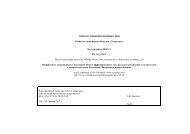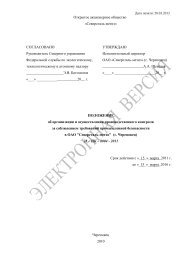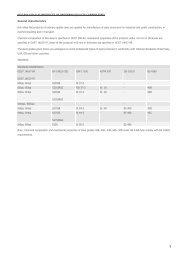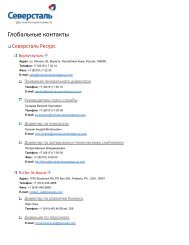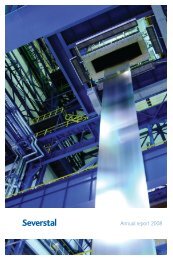Annual Report 2007 - Severstal
Annual Report 2007 - Severstal
Annual Report 2007 - Severstal
Create successful ePaper yourself
Turn your PDF publications into a flip-book with our unique Google optimized e-Paper software.
OAO <strong>Severstal</strong> and subsidiaries<br />
Notes to the consolidated financial statements<br />
for the year ended December 31, <strong>2007</strong><br />
(Amounts expressed in thousands of US dollars, except as otherwise stated)<br />
Effective interest method<br />
The effective interest method is a method of calculating the carrying value<br />
of a financial asset held at amortized cost and of allocating interest income<br />
over the relevant period. The effective interest rate is the rate that exactly<br />
discounts estimated future cash receipts (including all fees on points paid or<br />
received that form an integral part of the effective interest rate, transaction<br />
costs and other premiums or discounts) through the expected life of the<br />
financial asset, or, where appropriate, a shorter period.<br />
Income is recognised on an effective interest basis for debt instruments<br />
other than those financial assets designated as at FVTPL.<br />
Financial assets at FVTPL<br />
Financial assets are classified as at FVTPL where the financial asset is either<br />
held for trading or it is designated as at FVTPL.<br />
A financial asset is classified as held for trading if:<br />
– it has been acquired principally for the purpose of selling in the near future;<br />
or<br />
– it is a part of an identified portfolio of financial instruments that the<br />
Group manages together and has a recent actual pattern of short-term<br />
profit-taking.<br />
A financial asset other than a financial asset held for trading may be<br />
designated as at FVTPL upon initial recognition if:<br />
– such designation eliminates or significantly reduces a measurement<br />
or recognition inconsistency that would otherwise arise; or<br />
– the financial asset forms part of a group of financial instruments,<br />
which are managed and performance is evaluated on a fair value basis,<br />
in accordance with the Group's documented risk management or<br />
investment strategy, and information about the grouping is provided<br />
internally on that basis.<br />
Financial assets at FVTPL are stated at fair value, with any resultant gain or<br />
loss recognised in profit or loss. The net gain or loss recognised in profit or<br />
loss incorporates any dividend or interest earned on the financial asset.<br />
Held-to-maturity investments<br />
Bills of exchange and debentures with fixed or determinable payments<br />
and fixed maturity dates that the Group has the positive intent and<br />
ability to hold to maturity are classified as held-to-maturity investments.<br />
Held-to-maturity investments are recorded at amortised cost using the<br />
effective interest method less any impairment.<br />
AFS financial assets<br />
Available for sale financial assets are those non-derivative financial assets<br />
that are not classified as financial assets at FVTPL or held-to-maturity and<br />
are stated at fair value. Gains and losses arising from changes in fair value<br />
are recognised directly in equity with the exception of impairment losses,<br />
which are recognised directly in the income statement. Where the<br />
investment is disposed of or is determined to be impaired, the cumulative<br />
gain or loss previously recognised in the equity is included in the income<br />
statement for the period.<br />
Dividends on AFS equity instruments are recognised in the income<br />
statement when the Group’s right to receive the dividends is established.<br />
Loans and receivables<br />
Trade receivables, loans, and other receivables that have fixed or determinable<br />
payments that are not quoted in an active market are classified as loans and<br />
receivables. Loans and receivables are measured at amortised cost using<br />
the effective interest method, less any impairment. Interest income is<br />
recognised by applying the effective interest rate, except for short-term<br />
receivables when the recognition of interest would be immaterial.<br />
Derecognition of financial assets<br />
The Group derecognises a financial asset only when the contractual rights<br />
to the cash flows from the asset expire; or it transfers the financial asset<br />
and substantially all the risks and rewards of ownership of the asset to<br />
another entity.<br />
i. Financial liabilities<br />
Financial liabilities are classified as either financial liabilities ‘at FVTPL’<br />
or ‘other financial liabilities’.<br />
Financial liabilities at FVTPL<br />
Financial liabilities are classified as at FVTPL where the financial liability<br />
is either held for trading or it is designated as at FVTPL.<br />
A financial liability is classified as held for trading if:<br />
– it has been incurred principally for the purpose of repurchasing in the<br />
near future; or<br />
– it is a part of an identified portfolio of financial instruments that the<br />
Group manages together and has a recent actual pattern of short-term<br />
profit-taking.<br />
A financial liability other than a financial liability held for trading may be<br />
designated as at FVTPL upon initial recognition if:<br />
– such designation eliminates or significantly reduces a measurement<br />
or recognition inconsistency that would otherwise arise; or<br />
– the financial liability forms part of a group of financial instruments,<br />
which are managed and performance is evaluated on a fair value<br />
basis, in accordance with the Group's documented risk management<br />
or investment strategy, and information about the grouping is provided<br />
internally on that basis; or<br />
Financial liabilities at FVTPL are stated at fair value, with any resultant gain<br />
or loss recognized in profit or loss. The net gain or loss recognized in profit<br />
or loss incorporates any interest paid on the financial liability.<br />
Other financial liabilities<br />
Other financial liabilities, including borrowings, are initially measured at fair<br />
value, net of transaction costs. Borrowing costs on loans specifically for the<br />
purchase or construction of a qualifying asset are capitalized as part of the<br />
cost of the asset they are financing.<br />
Other financial liabilities are subsequently measured at amortized cost<br />
using the effective interest method, with interest expense recognized in<br />
the income statement.<br />
Derecognition of financial liabilities<br />
The Group derecognizes financial liabilities when, and only when, the<br />
Group’s obligations are discharged, cancelled or they expire.<br />
j. Dividends payable<br />
Dividends are recognized as a liability in the period in which they are<br />
authorized by the shareholders.<br />
k. Indirect taxes and contributions<br />
Indirect taxes and contributions are taxes and mandatory contributions<br />
paid to the government, or government controlled agencies, that are<br />
calculated on a variety of bases, but exclude taxes calculated on profits,<br />
value added taxes calculated on revenues and purchases and social<br />
security costs calculated on wages and salaries. Social security costs are<br />
included in cost of sales, distribution expenses and selling, general and<br />
administrative expenses in accordance with the nature of related wages<br />
and salaries expenses.<br />
<strong>Severstal</strong> <strong>Annual</strong> <strong>Report</strong> <strong>2007</strong> 81





